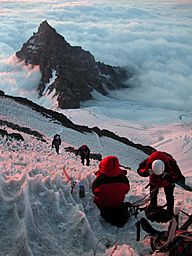Ingraham Glacier facts for kids
Quick facts for kids Ingraham Glacier |
|
|---|---|

Climbing Ingraham Glacier, Little Tahoma Peak below
|
|
| Type | Mountain glacier |
| Coordinates | 46°50′18″N 121°42′43″W / 46.83833°N 121.71194°W |
| Length | 2.6 mi (4.2 km) |
| Terminus | Icefall |
| Status | Retreating |
The Ingraham Glacier is a large river of ice found on the southeast side of Mount Rainier. Mount Rainier is a famous mountain in the state of Washington, USA. This glacier is named after Edward Sturgis Ingraham, who loved exploring Mount Rainier.
The Ingraham Glacier starts from the icy top of Mount Rainier. It flows east between a big rock called Gibraltar Rock, which is about 12,660 feet tall, and an area known as Disappointment Cleaver. To the north, it is separated from the even bigger Emmons Glacier by Little Tahoma Peak, which is about 11,138 feet tall. As it moves southeast, the Ingraham Glacier gets very close to the Cowlitz Glacier. These two glaciers almost meet at an elevation of about 6,700 feet. The water that melts from the Ingraham Glacier flows into the Cowlitz River.
History of Ingraham Glacier
Ancient Ice Flow
A very long time ago, about 35,000 years ago, the Ingraham and Cowlitz glaciers were much larger. They flowed about 62 miles down from Mount Rainier. This huge ice flow reached almost to where the town of Mossyrock, Washington is today.
Changes Over Time
More recently, the Ingraham and Cowlitz glaciers grew a little bit between the mid-1970s and mid-1980s. However, they have been shrinking overall since the end of the Little Ice Age. The Little Ice Age was a period of cooler temperatures that ended around the year 1850. During that time, the Ingraham and Cowlitz glaciers were connected. They ended at an elevation of about 5,600 feet. Since then, these glaciers have melted back more than 1 mile in the last 150 years.
A Sad Event
On June 21, 1981, a very sad event happened on Ingraham Glacier. Eleven climbers lost their lives in an icefall accident. An icefall is a dangerous area where ice breaks off and falls. Their bodies were never found.
Images for kids



